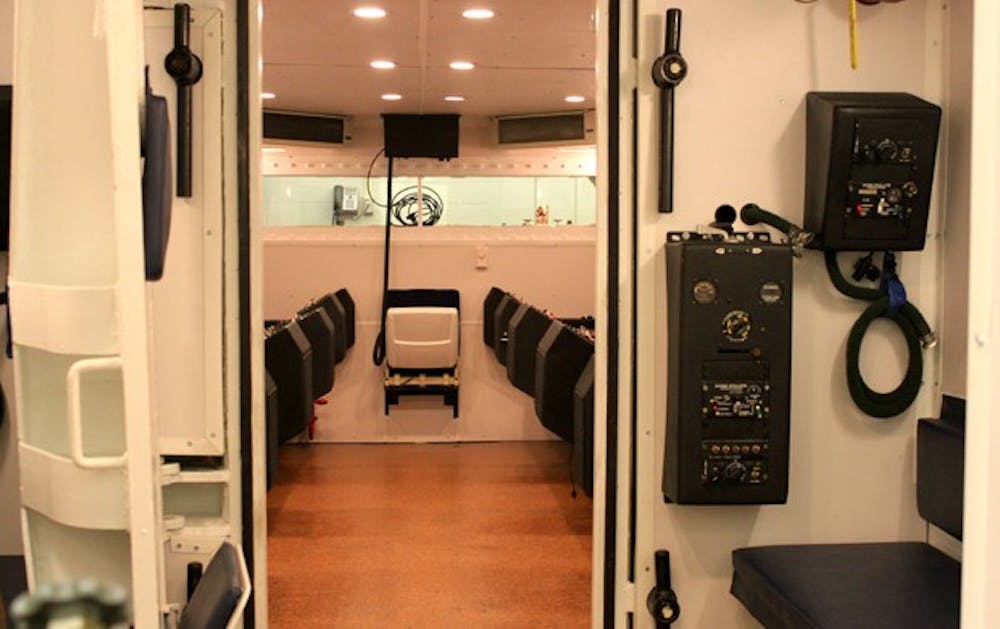“Go ahead and write your name again,” Altitude Chamber Manager Nat Daggs says over his headset in a Tennessee drawl.
Ten students from Westwind Aviation, a local aviation school, sit in the altitude chamber, each with a number over his or her head — one through 16. Inside, the chamber is simulating what people would feel like at 25,000 feet.
The altitude chamber sits in the middle of the room, resembling a submarine, with portholes to peer in and oxygen intercom panels inside. The people inside are unrecognizable, with oxygen masks veiling most of their faces and wearing identical uniforms. Outside the chamber, a four-foot high green oxygen tank sits outside the door, a tube winding into the chamber.
Soon students exit the altitude chamber, complaining of side effects from hypoxia, an ailment caused by lack of oxygen that the altitude chamber is supposed to teach them to detect. They compare worksheets and chuckle to each other over their answers to the questions.
Daggs is in charge of the altitude chamber on the Arizona State University Polytechnic campus and has been since it opened on June 29, 2001. Coincidentally, Daggs was stationed in the same building when the campus was Williams Air Force base. His current office is across the hall from his old one.
Daggs says sometimes pilots from commercial airlines visit the altitude chamber and pay for training themselves because it’s not required by the Federal Aviation Administration. Westwind has been a long time customer, Daggs says, but other groups use it too. Soon, the altitude chamber will be used to train civilians who wish to travel to space with a local business, RocketShip Tours.
RocketShip Tours, a travel agency in Phoenix, plans to be the first company in the U.S. to offer tours to space — for $95,000 a person. Jules Klar, CEO of RocketShip Tours, says the company plans to use the altitude chamber as part of their customer training, which should start in January.
“No one has ever taken passengers up to the edge of space, up to 200,000 feet, at 1,500 miles per hour,” he says. “It’s important to us that our customers have as much training as possible. This is safe, but being prepared never hurt anyone.”
Klar says people who pay for tours fly to space in a Lynx, a two-person spaceship, designed by XCOR Aerospace. Space tourists take off from California, but complete a four-day training program in Scottsdale, ending with the altitude chamber. Klar, who says he plans to be one of the first to fly in a Lynx once out of the testing phase, looks forward to training in the altitude chamber.
Daggs says while going into space is obviously a different experience than flying in an airplane, both situations are ones where hypoxia is possible. He says this training is appropriate for RocketShip Tours’ customers as well as people who travel in airplanes, so people are aware of the symptoms they may experience and can take action to avoid injury. Daggs says he gets tunnel vision, blurry vision and dizziness.
Westwind Aviation student Keith Cookman, otherwise known as number 14, experiences normal hypoxia symptoms during his time in the altitude chamber. Cookman is training to be a commercial airline pilot. He says he has hot and cold flashes and a headache. While inside, Daggs asks Cookman to remove his oxygen mask and begins to ask him simple math questions, which Cookman struggles with. After a time, Daggs instructs Cookman to put his mask back on.
Cookman fumbles with his mask, trying to pull the strap over his head.
“Now wait, you need to turn it back on,” Daggs says. “Come on, press the green button. Press the green button number 14. Press the green button.”
“I heard you!” Cookman says angrily. Another student turns on his mask for him and returns it to his face.
“Now that’s what we call belligerence,” Daggs says. “Some people get that. It’s not as common though. But some people will fight you and you need to just let them tire themselves out. Don’t fight them because they might incapacitate you.”
As he exits the altitude chamber, Cookman rubs his eyes and heads for the water fountain. Thirst is another effect of the chamber.
“You forget what you’re doing,” Cookman says, picking lint off his uniform. “It smells funny in there but you feel really happy. I wasn’t even mad, I just couldn’t do what they were asking.”
Cookman says he thinks this training is valuable and is glad his school offers it to him. Not all schools do, he says.
Daggs leaves students with instructions for the rest of the evening.
“No physical activity for 12 hours, drink lots of water,” Daggs says. “We also encourage you to limit yourself on alcohol because it’s going to hit you a lot harder. We haven’t had delayed effects from the altitude chamber in nine and a half years, let’s keep it that way.”
Reach the reporter at sheydt@asu.edu






